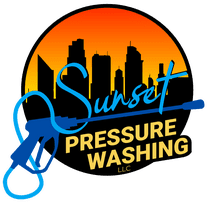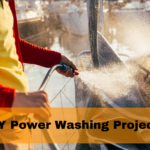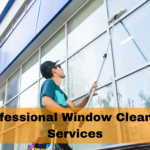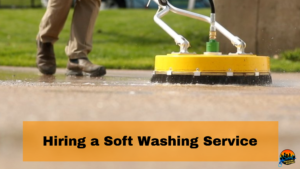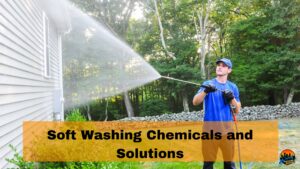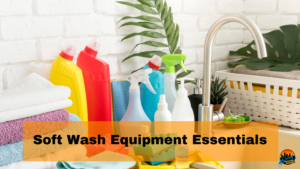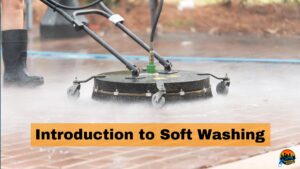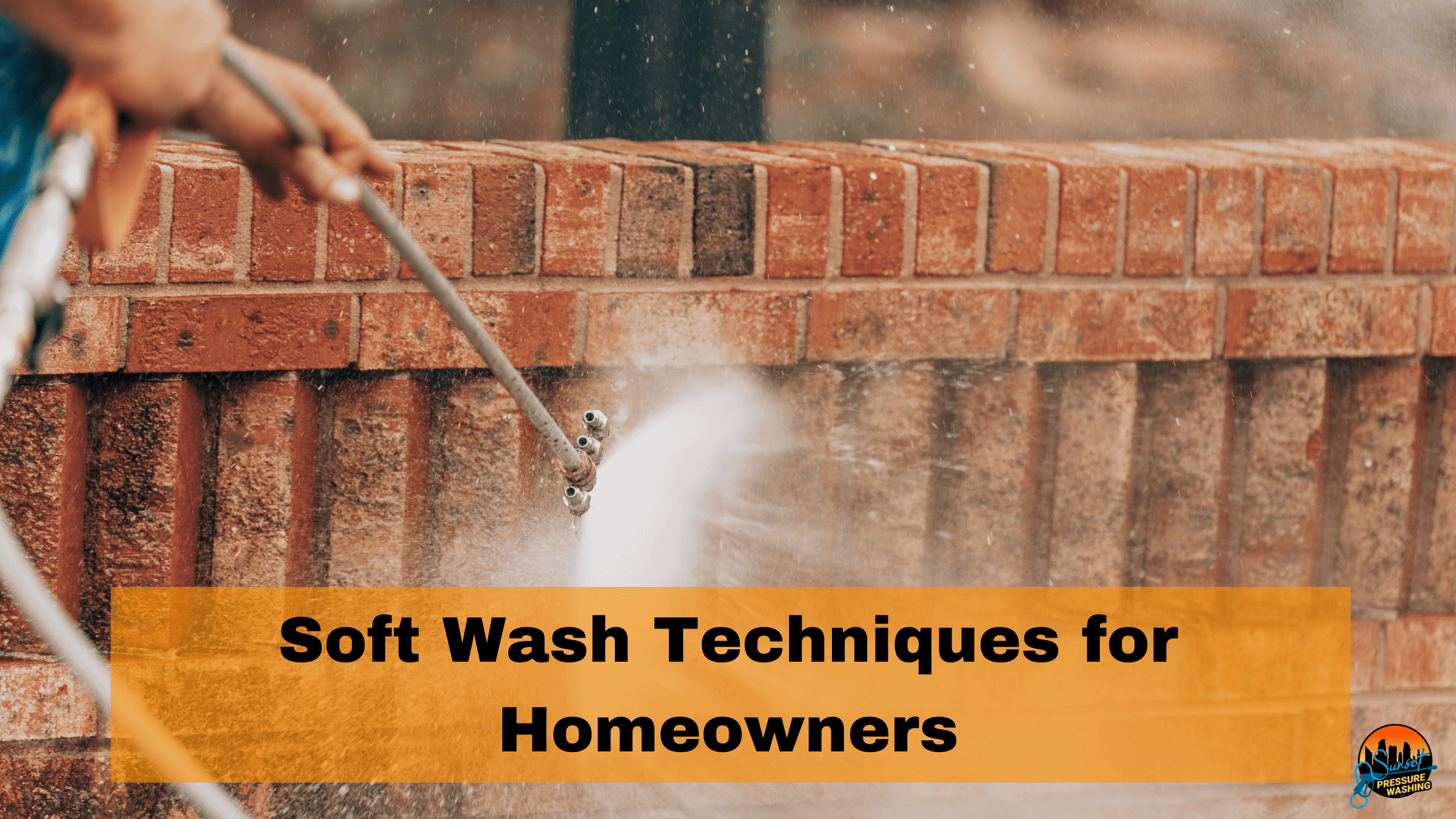
Soft Wash Techniques for Homeowners
Welcome to the gentle world of soft washing, a method that’s revolutionizing the way homeowners clean their exterior surfaces. Unlike its more aggressive counterpart, pressure washing, soft washing offers a tender yet effective solution for maintaining the beauty and integrity of your home’s facade. This method, which utilizes low-pressure water combined with specialized cleaning solutions, is gaining popularity for its ability to gently remove dirt, algae, mold, and other unsightly substances from surfaces that require a delicate touch.
Why turn to soft washing? The answer lies in its unparalleled ability to clean without the risk of damage that high-pressure systems pose to siding, roof shingles, wood decks, and other vulnerable areas. Beyond its effectiveness and safety, soft washing is also an environmentally friendly choice, relying on eco-conscious cleaning agents to do the heavy lifting.
Understanding Soft Washing
Soft washing represents a revolutionary approach to cleaning and maintaining the exterior of your home. Unlike traditional pressure washing, which relies on high-velocity water jets to remove dirt and grime, soft washing takes a gentler approach. This method combines low-pressure water with special cleaning solutions to effectively clean surfaces without causing damage.
At its core, soft washing is about precision and care. The process involves the application of cleaning agents at a pressure that is no greater than that of a garden hose. These cleaning agents are the real heroes of soft washing; they contain a blend of detergents, algaecides, and surfactants that penetrate and loosen dirt, algae, mold, and mildew at the molecular level. Once these substances are broken down, they can be easily rinsed away with low-pressure water, leaving surfaces clean and intact.
One of the most significant benefits of soft washing is its versatility and safety for a wide range of surfaces. It’s particularly effective on surfaces that can be damaged by high-pressure washing, such as roof shingles, siding, wood paneling, and delicate outdoor fixtures. Soft washing not only preserves the integrity of these surfaces but also extends their lifespan by removing harmful substances that can cause wear and degradation over time.
Moreover, soft washing is environmentally friendly. The cleaning solutions used are typically biodegradable and designed to have minimal impact on the surrounding landscape. This approach ensures that your home gets a deep clean without the risk of harming your garden, pets, or the local ecosystem.
The difference between soft washing and pressure washing isn’t just in the equipment or the pressure used; it’s also in the approach to cleaning. Soft washing is a more thoughtful, surface-specific cleaning method that takes into account the material being cleaned, its condition, and the type of dirt or organisms present. This tailored approach ensures that each part of your home’s exterior is treated with the care it needs, guaranteeing the best possible results without the risk of damage.
The Science Behind Soft Washing
Soft washing is not just a cleaning technique; it’s a science that combines low-pressure water with specialized cleaning solutions to remove dirt, algae, mold, and other unsightly substances from your home’s exterior surfaces without causing damage. This method is particularly effective on surfaces that are too delicate for high-pressure washing, such as roof shingles, siding, and wooden decks. Understanding the science behind soft washing can help homeowners appreciate why it’s often the preferred method for exterior cleaning.
The Role of Chemicals in Soft Washing
At the heart of soft washing are the cleaning solutions used. These solutions typically contain a blend of biodegradable chemicals that are effective against organic growths like mold, mildew, algae, and moss, as well as dirt and grime. One of the key components is a type of soap that helps the solution adhere to surfaces longer, allowing the chemicals more time to work. Another crucial ingredient is a sanitizer that kills the unwanted organisms at their roots, preventing them from quickly returning.
How Soft Washing Works
- The process begins when the soft washing solution is applied to the surface at a low pressure. This low pressure ensures that the cleaning solution is spread evenly without damaging the surface material. Once applied, the chemicals in the solution get to work, breaking down the bond between the dirt or organisms and the surface.
- The soap component in the solution reduces surface tension, allowing the cleaning agents to penetrate deeper into the material. This is particularly important for porous surfaces like wood or certain types of stone, where dirt and organisms can embed themselves below the surface level.
- The sanitizer component is what truly sets soft washing apart. By effectively killing mold, algae, and other growths, it addresses the problem at its source. This not only cleans the surface but also delays the return of these unsightly and potentially damaging organisms.
Environmental Considerations
One of the significant advantages of soft washing is its environmental friendliness. The chemicals used are designed to be biodegradable, breaking down into harmless substances after doing their job. Moreover, because soft washing uses chemicals to achieve results, less water is required compared to traditional pressure washing, contributing to water conservation efforts.
The Results
The result of soft washing is not just a clean surface but a sanitized one. Surfaces cleaned through soft washing stay clean longer because the root cause of the growth has been addressed. This prolongs the time between cleanings and helps maintain the structural integrity and aesthetic appeal of the home’s exterior surfaces.
The science behind soft washing lies in its use of specialized cleaning solutions applied at low pressure. These solutions, combined with the method’s gentle application, make soft washing an effective, environmentally friendly, and safe cleaning technique for delicate exterior surfaces.
Equipment and Tools Needed for Soft Washing
Soft washing your home isn’t just about protecting your property’s aesthetics; it’s about embracing a cleaning technique that ensures the longevity and beauty of your home’s exterior surfaces without the risk of damage associated with high-pressure washing. To achieve the best results, you’ll need the right set of tools and equipment. Here’s a detailed breakdown to help you get started:
Soft Wash System
A soft wash system typically includes a low-pressure pump that delivers cleaning solutions at pressures significantly lower than traditional pressure washers. This system can range from simple setups for small-scale, DIY projects to more sophisticated rigs for larger properties or commercial use. Key components include a pump, hoses, and a tank for your cleaning solution.
Chemicals and Cleaning Solutions
The effectiveness of soft washing comes from the use of specialized cleaning solutions that remove dirt, algae, mold, and mildew. These solutions often contain bleach (sodium hypochlorite) mixed with water and sometimes a surfactant, which helps the solution cling to surfaces for a deeper clean. It’s important to choose eco-friendly and surface-appropriate solutions to avoid harming your landscaping or exterior finishes.
Nozzles and Sprayers
The right nozzles and sprayers are crucial for applying cleaning solutions gently and efficiently. Soft washing uses specific nozzles that fit onto the end of your hoses to adequately spread the cleaning solution over a wide area without excessive pressure. Adjustable nozzles allow you to control the spray pattern and reach, ensuring an even application across all surfaces.
Safety Gear
When dealing with chemicals, safety cannot be overstated. Personal protective equipment (PPE) is essential to protect yourself from the potentially harmful effects of the cleaning solutions. This includes chemical-resistant gloves, eye protection, and sometimes even a respirator mask, especially if you’re sensitive to the chemicals used in the cleaning process.
Ladders and Scaffolding
Depending on the height and complexity of your home’s architecture, you may need ladders or scaffolding to reach higher areas safely. It’s crucial to ensure that any equipment used for elevation is stable and secure to prevent accidents.
Gutter Cleaning Tools
Soft washing extends beyond your home’s siding or brickwork; it also includes gutter maintenance. Tools like gutter scoops or specialized gutter cleaning attachments for your hose can help clear debris and ensure that your gutters are prepared for treatment with the soft wash solution.
Protective Coverings for Plants and Landscaping
The chemicals used in soft washing can be harmful to plants and landscaping. Before starting, it’s wise to have protective coverings or tarps available to cover sensitive areas. Additionally, pre-soaking plants with water can help prevent them from absorbing the cleaning solution.
Step-by-Step Guide to Soft Washing Your Home
Soft washing is a gentle yet effective cleaning method ideal for maintaining your home’s exterior without risking damage to delicate surfaces. This guide will walk you through the process, ensuring you’re well-equipped to refresh your home safely and efficiently.
Step 1: Prepare Your Home
- Clear the Area: Move outdoor furniture, planters, and any movable objects away from the walls. Cover plants and landscaping near the house to protect them from cleaning solutions.
- Close Windows and Doors: Ensure all windows and doors are tightly closed to prevent water and cleaning solutions from entering your home.
Step 2: Mix Your Cleaning Solution
- Choose the Right Cleaner: Select a cleaner suitable for soft washing, focusing on eco-friendly and surface-appropriate options.
- Mix According to Instructions: Dilute the cleaning solution with water in a large bucket or tank according to the manufacturer’s instructions. The typical ratio often ranges from 1:10 to 1:50, cleaner to water.
Step 3: Set Up Your Soft Wash System
- Prepare the Equipment: Connect your soft wash system to a water source and fill it with your mixed cleaning solution. Ensure all connections are secure to prevent leaks.
- Test the System: Briefly test your soft wash setup on a small, inconspicuous area to ensure it’s working correctly and the solution is not too strong.
Step 4: Apply the Cleaning Solution
- Start from the Bottom: Begin applying the cleaning solution from the bottom of the surface and gradually work your way up. This method helps prevent streaks and ensures even coverage.
- Ensure Even Application: Use a low-pressure nozzle to spray the solution evenly across the surface, taking care to cover all areas thoroughly.
Step 5: Let the Solution Sit
- Dwell Time: Allow the cleaning solution to sit on the surface for the recommended amount of time, usually between 10 to 20 minutes. Avoid letting the solution dry completely, as this can reduce its effectiveness.
- Monitor the Surface: Keep an eye on the surface for any signs of excessive runoff or damage. If necessary, mist the area with water to keep it moist during the dwell time.
Step 5: Let the Solution Sit
- Rinse Thoroughly: Using clean water, rinse the surface thoroughly with a low-pressure setting. Start from the top and work your way down to ensure all cleaning solution and loosened debris are washed away.
- Be Gentle: Maintain a safe distance with the nozzle to avoid water pressure damage. The goal is to rinse, not to blast the surface.
Step 7: Inspect and Touch Up
- Inspect the Area: Once the surface is dry, inspect for any missed spots or areas that may need a second application.
- Touch Up as Needed: Apply additional cleaning solution to stubborn areas if necessary, following the same process as before.
Step 8: Clean Up
- Restore the Area: Once you’re satisfied with the cleaning, move furniture and other items back to their places. Remove any protective coverings from plants and landscaping.
- Equipment Maintenance: Clean your soft wash equipment according to the manufacturer’s instructions to ensure it’s ready for next time.
Soft washing your home can significantly improve its appearance and longevity. By following these steps carefully, you’ll ensure a successful clean without risking damage to your property. Remember, regular maintenance is key to keeping your home looking its best year-round.
Common Mistakes to Avoid in Soft Washing
When it comes to soft washing your home, embracing the right techniques is crucial to avoid damage and ensure a thorough clean. Despite its simplicity and effectiveness, there are several common mistakes homeowners often make during the process. Understanding and avoiding these pitfalls can significantly enhance the results of your soft washing efforts.
1. Using Incorrect Chemical Concentrations
One of the most critical aspects of soft washing is the chemical solution used. A common mistake is using the wrong concentration—too strong can damage your home’s exterior surfaces, while too weak may not be effective against dirt, mold, and algae. It’s important to follow recommended ratios or consult with professionals to find the right balance for your specific needs.
2. Overlooking Plant and Property Protection
Soft washing chemicals can harm plants, grass, and certain materials around your home if not properly managed. Failing to cover or water plants thoroughly before and after the process can lead to damage. Similarly, not taking precautions to protect vulnerable materials on your property can result in unwanted harm.
3. Ignoring Weather Conditions
The effectiveness of soft washing can be influenced by weather conditions. Attempting to soft wash in extreme heat, wind, or just before a rainstorm can affect the drying time and how well the cleaning agents work. Ideal conditions are overcast with mild temperatures, ensuring that the solution acts effectively without quick drying.
4. Inadequate Rinsing
After applying the cleaning solution, rinsing it off thoroughly is crucial. Inadequate rinsing can leave residue that not only looks unsightly but can also attract dirt and grime, counteracting the cleaning process. Ensure that all areas are well-rinsed with water to remove any remaining cleaning agents.
5. Neglecting Safety Precautions
Soft washing involves chemicals that can be hazardous if mishandled. Neglecting safety precautions like wearing protective eyewear, gloves, and clothing can lead to accidents and injuries. Always prioritize safety by preparing appropriately and following the recommended guidelines for handling and applying the cleaning solutions.
6. Applying Excessive Pressure
While soft washing operates at significantly lower pressures than power washing, some homeowners may still use too much force. This can lead to water intrusion in siding, windows, or other vulnerable areas. Always use the lowest effective pressure and keep a proper distance to protect your home’s exterior.
7. Lack of Maintenance Cleaning
Finally, a common oversight is the lack of maintenance cleaning. Soft washing is not a one-and-done solution; regular maintenance is key to preventing the buildup of algae, mold, and dirt. Neglecting periodic cleaning can lead to the need for more aggressive methods in the future, which could have been avoided with regular upkeep.
By steering clear of these common mistakes, homeowners can maximize the benefits of soft washing, ensuring their home not only looks its best but is also protected from potential damage.
Professional vs. DIY Soft Washing
When it comes to maintaining the exterior of your home, soft washing stands out as a gentle yet effective cleaning method. As homeowners weigh the options between hiring a professional service and taking on the task themselves, several factors come into play. This section explores the pros and cons of professional versus DIY soft washing to help you make an informed decision.
Professional Soft Washing: The Expert Touch
Pros:
- Expertise and Experience: Professional soft wash technicians bring a wealth of knowledge and experience. They can identify the most stubborn stains and understand the best treatment for different surfaces, ensuring a thorough clean without damage.
- Advanced Equipment: Professionals have access to high-grade equipment and cleaning solutions that may not be readily available to the average homeowner. This equipment allows for more efficient and effective cleaning.
- Time and Convenience: Hiring professionals saves homeowners time and effort. The convenience of scheduling a service without dedicating personal time and labor is a significant advantage.
- Safety: Soft washing involves working at heights and handling chemicals. Professionals are trained in safety protocols to prevent accidents, making it a safer option overall.
Cons:
- Cost: The primary downside to hiring professionals is the cost. Professional soft washing services can be more expensive upfront compared to doing it yourself.
- Availability: Depending on your location, finding a reputable soft washing service may be challenging, and scheduling can be subject to their availability.
DIY Soft Washing: Taking Matters into Your Own Hands
Pros:
- Cost-Effective: Doing it yourself can save money. Homeowners only need to invest in the necessary equipment and cleaning solutions, which can be used multiple times.
- Flexibility: DIY allows homeowners to work on their own schedule. You can choose the most convenient time for you, and if you need to pause or spread the work over several days, you have the flexibility to do so.
- Personal Satisfaction: There’s a sense of achievement and satisfaction that comes from completing the task yourself and maintaining your home’s beauty and longevity.
Cons:
- Risk of Damage: Without the proper knowledge and experience, there’s a higher risk of damaging your home’s exterior by using incorrect solutions or pressure settings.
- Safety Risks: The DIY approach involves risks, especially when working on ladders or handling chemical solutions without proper protective gear.
- Investment in Equipment: Although it’s cost-effective in the long run, the initial investment in the right equipment and cleaning solutions can be significant.
Making the Decision
Deciding between professional and DIY soft washing ultimately depends on your specific circumstances, including your budget, the complexity of the job, and your comfort level with the tasks involved. If your home requires extensive cleaning or if you’re concerned about the possibility of damage, hiring professionals might be the best choice. On the other hand, if you have the time, necessary equipment, and confidence in your ability to safely handle the job, DIY soft washing can be a rewarding project that saves money.
Regardless of the route you choose, maintaining your home’s exterior through soft washing is an investment in its longevity and curb appeal. Taking the time to consider your options carefully will ensure that your home gets the care it needs in the most efficient way possible.
Embrace the Gentle Power of Soft Washing
As we’ve navigated through the gentle yet effective world of soft washing, it’s clear that this method is not just about maintaining the aesthetic appeal of your home but also about preserving its integrity. Soft washing stands out as a superior cleaning technique, especially for those delicate surfaces that demand a tender touch. Whether you’re battling stubborn mold, unsightly algae, or just the everyday accumulation of dirt and grime, soft washing offers a solution that is both efficient and safe for your home and the environment.
At Sunset Pressure Washing, we specialize in bringing this gentle cleaning power to your doorstep. Our comprehensive range of soft washing services is designed to rejuvenate your home’s exterior without the risk of damage that comes with traditional pressure washing methods. From siding and roofs to decks and driveways, our expert team ensures that every inch of your home is treated with the utmost care, leaving it sparkling clean and preserving its beauty for years to come.
We understand that the idea of soft washing might be new to some, and the decision between taking a DIY approach or entrusting your home to professionals can be daunting. That’s why we’re here to guide you every step of the way. By choosing Sunset Pressure Wash, you’re not just getting a service; you’re getting a partner dedicated to the longevity and aesthetics of your home.
At Sunset Pressure Washing, explore our services and discover how we can transform your home’s exterior with our gentle yet effective cleaning solutions. Don’t let dirt and grime dull your home’s sparkle. Reach us and take the first step towards a cleaner, brighter home.
